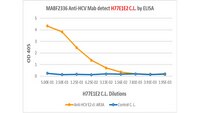Human broadly neutralizing antibodies to the envelope glycoprotein complex of hepatitis C virus
Erick Giang 1 , Marcus Dorner, Jannick C Prentoe, Marlène Dreux, Matthew J Evans, Jens Bukh, Charles M Rice, Alexander Ploss, Dennis R Burton, Mansun Law
Proc Natl Acad Sci U S A
109(16)
6205-10
2012
Show Abstract
Hepatitis C virus (HCV) infects ∼2% of the world's population. It is estimated that there are more than 500,000 new infections annually in Egypt, the country with the highest HCV prevalence. An effective vaccine would help control this expanding global health burden. HCV is highly variable, and an effective vaccine should target conserved T- and B-cell epitopes of the virus. Conserved B-cell epitopes overlapping the CD81 receptor-binding site (CD81bs) on the E2 viral envelope glycoprotein have been reported previously and provide promising vaccine targets. In this study, we isolated 73 human mAbs recognizing five distinct antigenic regions on the virus envelope glycoprotein complex E1E2 from an HCV-immune phage-display antibody library by using an exhaustive-panning strategy. Many of these mAbs were broadly neutralizing. In particular, the mAb AR4A, recognizing a discontinuous epitope outside the CD81bs on the E1E2 complex, has an exceptionally broad neutralizing activity toward diverse HCV genotypes and protects against heterologous HCV challenge in a small animal model. The mAb panel will be useful for the design and development of vaccine candidates to elicit broadly neutralizing antibodies to HCV. | 22492964
 |
Broadly neutralizing antibodies protect against hepatitis C virus quasispecies challenge
Mansun Law 1 , Toshiaki Maruyama, Jamie Lewis, Erick Giang, Alexander W Tarr, Zania Stamataki, Pablo Gastaminza, Francis V Chisari, Ian M Jones, Robert I Fox, Jonathan K Ball, Jane A McKeating, Norman M Kneteman, Dennis R Burton
Nat Med
14(1)
25-7
2008
Show Abstract
A major problem in hepatitis C virus (HCV) immunotherapy or vaccine design is the extreme variability of the virus. We identified human monoclonal antibodies (mAbs) that neutralize genetically diverse HCV isolates and protect against heterologous HCV quasispecies challenge in a human liver-chimeric mouse model. The results provide evidence that broadly neutralizing antibodies to HCV protect against heterologous viral infection and suggest that a prophylactic vaccine against HCV may be achievable. | 18064037
 |









